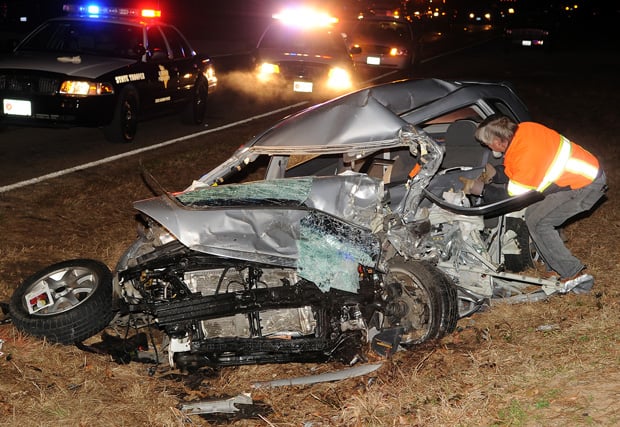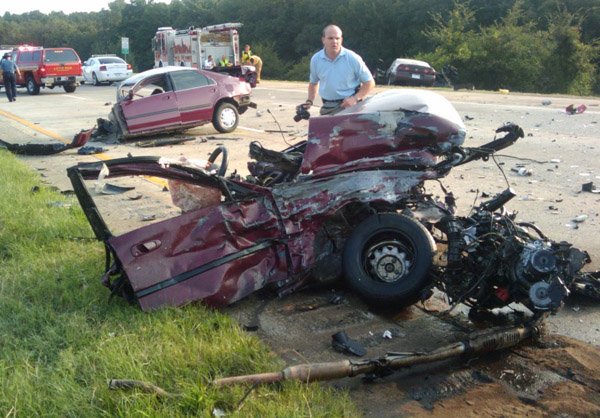Source(Google.com.pk)
Fatal Car Crash Biography
Crash, boom, bang! In an instant, a car accident can change a person’s life forever. Each year, many unsuspecting drivers, passengers, and pedestrians are killed on the roads of the United States. The main question we ask ourselves is why? Are people killed because of high speed crashes? Did the airbags not deploy at the proper time? Were the roads in acceptable condition.
Unfortunately, we can not always determine the causes of all accidents, simply because we were not on the scene of the accident. There are many different reasons why fatal car accidents occur. Some accidents involve distractions, alcohol consumption, road hazards, or inclement weather.
In this econometric paper, the goal is to determine why fatal car accidents occur and what we can do to prevent a possible fatal accident from occurring.
The following empirical equation is used to determine fatal car accidents (per 100,000 registered vehicles) using ten independent variables. Cross sectional data is collected from 2003, from all fifty states.
Where FCA measures the total number of fatal car accidents per 100,000 registered vehicles.
Table 1 lists the independent variables, their definitions, and their expected effect on fatal car accidents.
2003. Specifically, this variable is measured by the amount of dollars spent in 2003 (in thousands) for funding highways, divided by the total road length miles (in thousands) in 2003 for each of the fifty states. According to Peters (2004), SAFETEA or The Safe, Accountable, Flexible, and Efficient Transportation Equity Act of 2003 is greatly increasing highway funding and making roads safer. When more money is spent per mile on highways, we would expect that fewer fatal car accidents will occur because roads are likely to be safer, due to newly constructed roads, more rumble strips, sturdier guard rails, and medians. Therefore, the expected sign of the coefficient of this independent variable is negative.
The independent variable ROD measures the total amount of very good and good roads, divided by the total number of roads in each of the fifty states. The better the road conditions, the less likelihood of a fatal accident. When road conditions are very good or good, we consider them to be safe roads. For example, Persaud, Retting, and Lyon (2004) indicate that roads with rumble strips reduce fatalities by up to 25 percent; many good, safe roads have rumple strips. Thus, safe roads often lead to fewer accidents because they will not be as dangerous at higher speeds to drivers as roads that are considered fair, mediocre, or poor. As a result, the expected sign of the coefficient of this independent variable is negative.
The independent variable SAF is the amount of funding for highway safety programs per registered motor vehicle in 2003, measured by the total amount of allocated federal funds for safety programs in each of the fifty states (in thousands of dollars), divided by the total motor vehicle registrations in each of the fifty states (in thousands of registered drivers). According to Dorn and Barker (2004), drivers that follow highway safety professional driver training are safer drivers than those who do not follow a highway safety program. When more money is spent per registered motor vehicle for highway safety programs, we would expect that fewer fatal car accidents will occur because drivers will be provided with education and safety programs. As a result, there will be a reduction in fatal car accidents. Thus, the expected sign of the coefficient of this independent variable is negative.
The independent variable MIL is the average amount of total vehicle miles traveled per registered motor vehicle in each of the fifty states (in thousands) in 2003. The more miles a driver puts on a vehicle, the more likely they are to be involved in a fatal car accident because high mileage drivers spend a significant amount of time on the roads. As a result, the expected sign of the coefficient of this independent variable is positive.
The independent variable GAS is the average 2003 unleaded fuel price in each of the fifty states (in dollars).










Fatal Car Crash Biography
Crash, boom, bang! In an instant, a car accident can change a person’s life forever. Each year, many unsuspecting drivers, passengers, and pedestrians are killed on the roads of the United States. The main question we ask ourselves is why? Are people killed because of high speed crashes? Did the airbags not deploy at the proper time? Were the roads in acceptable condition.
Unfortunately, we can not always determine the causes of all accidents, simply because we were not on the scene of the accident. There are many different reasons why fatal car accidents occur. Some accidents involve distractions, alcohol consumption, road hazards, or inclement weather.
In this econometric paper, the goal is to determine why fatal car accidents occur and what we can do to prevent a possible fatal accident from occurring.
The following empirical equation is used to determine fatal car accidents (per 100,000 registered vehicles) using ten independent variables. Cross sectional data is collected from 2003, from all fifty states.
Where FCA measures the total number of fatal car accidents per 100,000 registered vehicles.
Table 1 lists the independent variables, their definitions, and their expected effect on fatal car accidents.
2003. Specifically, this variable is measured by the amount of dollars spent in 2003 (in thousands) for funding highways, divided by the total road length miles (in thousands) in 2003 for each of the fifty states. According to Peters (2004), SAFETEA or The Safe, Accountable, Flexible, and Efficient Transportation Equity Act of 2003 is greatly increasing highway funding and making roads safer. When more money is spent per mile on highways, we would expect that fewer fatal car accidents will occur because roads are likely to be safer, due to newly constructed roads, more rumble strips, sturdier guard rails, and medians. Therefore, the expected sign of the coefficient of this independent variable is negative.
The independent variable ROD measures the total amount of very good and good roads, divided by the total number of roads in each of the fifty states. The better the road conditions, the less likelihood of a fatal accident. When road conditions are very good or good, we consider them to be safe roads. For example, Persaud, Retting, and Lyon (2004) indicate that roads with rumble strips reduce fatalities by up to 25 percent; many good, safe roads have rumple strips. Thus, safe roads often lead to fewer accidents because they will not be as dangerous at higher speeds to drivers as roads that are considered fair, mediocre, or poor. As a result, the expected sign of the coefficient of this independent variable is negative.
The independent variable SAF is the amount of funding for highway safety programs per registered motor vehicle in 2003, measured by the total amount of allocated federal funds for safety programs in each of the fifty states (in thousands of dollars), divided by the total motor vehicle registrations in each of the fifty states (in thousands of registered drivers). According to Dorn and Barker (2004), drivers that follow highway safety professional driver training are safer drivers than those who do not follow a highway safety program. When more money is spent per registered motor vehicle for highway safety programs, we would expect that fewer fatal car accidents will occur because drivers will be provided with education and safety programs. As a result, there will be a reduction in fatal car accidents. Thus, the expected sign of the coefficient of this independent variable is negative.
The independent variable MIL is the average amount of total vehicle miles traveled per registered motor vehicle in each of the fifty states (in thousands) in 2003. The more miles a driver puts on a vehicle, the more likely they are to be involved in a fatal car accident because high mileage drivers spend a significant amount of time on the roads. As a result, the expected sign of the coefficient of this independent variable is positive.
The independent variable GAS is the average 2003 unleaded fuel price in each of the fifty states (in dollars).
Fatal Car Crash

Fatal Car Crash

Fatal Car Crash

Fatal Car Crash

Fatal Car Crash

Fatal Car Crash

Fatal Car Crash

Fatal Car Crash

Fatal Car Crash

Fatal Car Crash

Fatal Car Crash
No comments:
Post a Comment